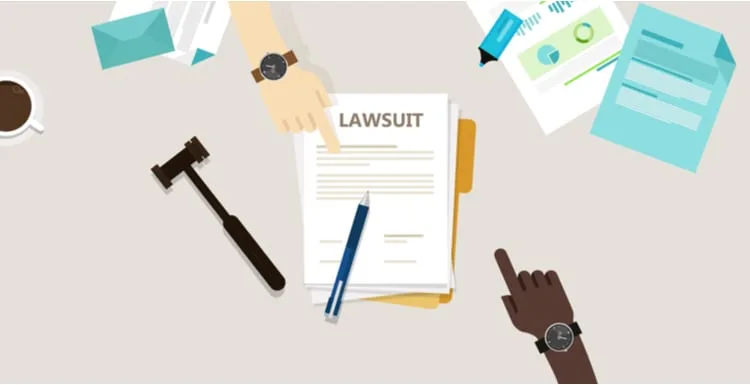Errors and omissions (E&O) refer to the professional liability risks that real estate agents and home inspectors face every day. Many times, you may not even know you’ve made a mistake.
Regardless of your intention, these mistakes can be costly. In extreme cases, you may lose the business you’ve worked so hard to build.
Fortunately for you, errors and omissions insurance adds a layer of protection against these mistakes. It’s so important that many states even require agents to carry an E&O policy before granting a new real estate license.
In this article, we’ll cover the ins and outs of this insurance product, its benefits, pricing, and the best places to get a policy. Read on to learn more.
What is Errors and Omissions Insurance?

Telnov Oleksii/Shutterstock
As Kimberlee Leonard, a former insurance agency owner, explains it,
Errors and Omissions insurance is a specific type of insurance policy that protects a real estate professional from accusations that they did not render professional services or fulfill the contractual obligations. These are often unintentional acts or could be from a disgruntled client who is making things up hoping for a settlement. Either way, an E&O policy protects you from the claim and subsequent lawsuit.
Let’s go over that again. If a client believes you have made an oversight or mistake, they can sue you. Errors and omissions insurance (also called professional liability insurance) helps to safeguard you in the event that you are sued, potentially covering the cost of the lawsuit.
The funny thing about errors and omissions is that they’re subjective. They’re mostly based on your client’s perception of your professional services, which may not match the reality of the situation.
Still, clients can accuse you of doing something wrong by either not fulfilling your professional duties or making a mistake, and you need to make sure you’re covered just in case.
So, what counts as an error, and what counts as an omission? There are a few things, such as:
Common Household Issues
A home can look beautiful on the outside but hide some pretty scary stuff on the inside. There are literally dozens of issues a house can suffer from. The most common include:
- Mold
- Radon
- Roof leaks
- Lead paint
- Insect infestation
- Asbestos
- Rodent infestation
- Septic tank problems
That list could go on! You’re well aware that you’re legally required to disclose issues such as these to potential buyers. The problem is, you may not be aware of the issues yourself.
Even with a good inspection and appraisal, some problems may slip through the cracks. If a buyer discovers a problem after the sale, then they can try to claim you faltered in your duties and they are owed financial compensation because of it.
Other Issues
But disclosures are only one part of E&O lawsuits. Other reasons you can be sued include:
- Breach of fiduciary duty
- Failing to act in the client’s best financial interest
- Failure to disclose structural or physical problems with a property
- Failure to inform clients about any liens on a property
- RESPA violations
- Failure to check the accuracy of the information listed about a property
The professional duties you must adhere to depend on the laws in the state where you’re licensed, so it’s hard to make blanket statements on violations. However, we can give an example to highlight the need for these policies.
Examples
To illustrate our point, let’s use an example to illustrate how a claim might play out. Leonard explains that E&O insurance protects you from three major items: misrepresentation, giving incorrect advice, and violating good faith, and includes an example of each below:
- Misrepresentation might be telling a client that there are no known issues with the plumbing when there is knowledge of a plumber being scheduled to fix an underground leak.
- Giving incorrect advice is telling someone that the 15-year old roof looks like it is in good condition and a roofing inspection is not needed.
- A violation of good faith could be disclosing personal reasons for selling your home to a potential buyer that gives them a better negotiation advantage, such as needing to sell quickly for a divorce.
E&O lawsuits are unpredictable because there are a number of problems you can be sued for not disclosing, even some you may not think of. That’s exactly why you need coverage for errors and omissions.
What Doesn’t Count as Errors and Omissions?

Scarlette/Shutterstock
The disputes over errors and omissions are only about oversights and mistakes related to your professional real estate work. There are other issues that can arise before, during, and after real estate transactions that aren’t covered by E&O insurance.
Things not covered by E&O insurance include:
- Fraud
- Intentional wrongdoings
- Crimes
E&O insurance also won’t cover any lawsuits initiated by a law enforcement agency or the federal government over RESPA violations.
It also won’t cover any work you may do outside the scope of your duties as a real estate agent, so keep that in mind when working with your clients so you can protect yourself.
How Much Does Errors and Omissions Insurance Cost?
Just as with any other type of insurance, you choose a plan based on what you do, then pay a premium each year for coverage. On average, real estate agents pay about $660 for E&O.
Some real estate brokers sell errors and omissions insurance to their agents as part of a package of services. Just be warned that this type of coverage isn’t always the best for you.
If you’re a real estate appraiser, you’ll pay a little more at about $790, and if you’re a title agent or closing agent, you’ll pay about $1250 per year.
Agent and SparkRental founder Denise Supplee says:
Overall, E & O insurance can cost anywhere from $600 – $1400 annually. I pay $600 per year through my broker in Pennsylvania.
Whether or not it’s included in your employment contract, be sure to look into the fine print. Specifically, pay close attention to the coverage provided and the limits of that coverage. In most cases, these are blanket limits for all agents, not just for you specifically.
If you live in a state that requires you to have your own E&O insurance (which is covered in the next section), then you must have your own in order to maintain your real estate license.
States Where E&O Insurance Is Required

BlocBerry/Shutterstock
In some states, you’re required by law to get E&O insurance. These states include:
- Idaho
- Wyoming
- Colorado
- New Mexico
- North Dakota
- South Dakota
- Nebraska
- Iowa
- Kentucky
- Tennessee
- Mississippi
- Rhode Island
Even if you are not required by law to buy this type of insurance to practice as a real estate agent, it’s not a bad idea.
As discussed previously, there are a lot of reasons an agent can be sued, so it’s smart to have a strategy for risk management that accounts for the potential costs of a lawsuit.
There are also some situations where a parent real estate agency or business partner will require you to have E&O insurance. They may require this just in case:
- You work as a contractor. Some agencies that employ agents as independent contractors will require E&O insurance simply because it protects them in case you get sued. If you have your own insurance, then their insurance won’t have to cover as much.
- A client has issues with a sale. If you’re in business with someone else, then an unhappy client can go after anyone involved in the transaction, such as appraisers, agents, and brokers. A business partner will want to know you’re covered so that the costs of any potential legal actions won’t fall on them.
How E&O Insurance Works

Dim Tik/Shutterstock
Sales are a big part of what a real estate agent does every day. Usually, very little goes wrong over the course of these transactions. However, in the event there is an issue, then your client can sue you.
The cost of this lawsuit could sink your career and your business, which is why you have E&O coverage, which serves as liability coverage. The insurance pays any legal fees and costs associated with lawsuits your business may encounter.
You pay a premium each month for insurance that can help give you peace of mind—it’s protection in case something goes wrong.
A typical E&O insurance policy covers:
- Court costs
- Defense costs
- Witness fees
- Settlements
- Judgments
- Lawyer’s fees
- Other legal expenses
Read over your individual policy carefully to make sure it provides the coverage you’re looking for.
Typical E&O Lawsuit Cost

Deviyanthi79/Shutterstock
Lawsuits come in every shape and size you can imagine, so it’s difficult to really estimate what a lawsuit might cost. But you can look at case studies to see the range of the typical real estate lawsuit. Check these numbers out:
Frivolous lawsuits: $2,000 to $5,000
A lawsuit like this is one that is based on an unfair complaint that a judge simply throws out. Don’t be fooled into thinking that because it’s thrown out, it doesn’t cost anything.
Small business owners are still on the hook for thousands of dollars, even if the claim was unfair and ultimately went nowhere.
Typical E&O lawsuit: around $44,000
Research has shown that an E&O case based on malpractice can cost up to $44,000 in legal fees. This number depends on several factors, such as where the case is filed, whether damages are owed, what the outcome was, and several other aspects of the case.
Other Costs
Believe it or not, it’s not just the lawsuit you’ll be on the hook for; there are costs outside your legal bills.
You also must consider how this will affect your reputation. After all, many real estate agents use recommendations and reviews to generate business.
In a competitive market, one black mark on your record could spell doom. If you have insurance, then any issues can be quickly and quietly resolved without putting your reputation on the line.
How to Protect Yourself

Jorgen Mcleman/Shutterstock
Getting E&O insurance can only take you so far in protecting your reputation and your business; the rest is up to you. There are some practical steps you can take to lessen the likelihood of client litigation.
A lot of the time, the “mistakes” that lead to lawsuits are client overreactions to an issue with a home purchase or a miscommunication.
You have to cut them a little slack. You may deal day in and day out with buying a home, but for many people, it’s a high-stakes game, and emotions can run high. To prevent lawsuits, you should:
Communicate Effectively
The real estate business is about three things: location, location, location—right? But you could easily replace that with communication.
It’s crucial to learn how to clearly, effectively, and concisely communicate things during the home buying and selling process with your clients. Be crystal clear.
Document Everything
Don’t be afraid to take copious notes and back up conversations you have with your clients with written communication. Following up on conversations with an email is a very easy way to do this.
Confirm things you agreed about in person in writing after the fact, and keep all the information related to each sale organized.
Nurture Relationships
Solid relationships are the cornerstone of real estate business practices and can help you be successful, but they can also help you avoid a lawsuit.
Clients will be less likely to take legal action against you if they feel like they can have an open and honest conversation with you about issues they have with a property.
Don’t Go Above and Beyond
It can be tempting to appear as if you’re really providing services to your client that exceed expectations, but be careful not to go outside your own area of expertise.
You can land yourself in legal hot water if you offer advice you’re simply not qualified to give. Don’t make recommendations to sellers, buyers, referring contractors, or other service providers. Stick to what you know best and what you are actually contracted to do.
Disclose, Disclose, Disclose
When I was getting my real estate license, my instructor told the class that there was nothing wrong with over-disclosing.
After all, you should have nothing to hide. If your client insists on hiding information, then you should find the door quickly.
At the end of the day, disclosing all relevant information shows that you’re shying away from gray areas, which will ultimately help you should you ever be called to stand before a judge.
Know Your State’s Code of Ethics and Laws
Obviously, violating state law is one very easy way to get yourself into legal trouble, so you should familiarize yourself with any laws that apply to your real estate business and stick to them.
Your code of ethics is also important to learn by heart. If you ever deviate from your code of ethics, it’s ammunition you provide to anyone who might look to sue you. If a lawyer can prove you violated ethics or laws, then you’re in big trouble.
You cannot prevent every single lawsuit, but putting these strategies into action can help minimize problems or avoid disputes. Be smart!
Tip: Continuing education programs offer annual updates and changes to regulations. Save time with online CE programs from McKissock.
Where to Buy E&O Insurance

Dim Tik/Shutterstock
Now that you’re convinced you need E&O insurance, where do you get it? You can find it through most national insurance agencies. Simply contact a reputable agency to ask for an insurance quote.
If you’re a Realtor, then the National Association of Realtors offers insurance in partnership with Victor O. Schinnerer & Company, Inc. to provide insurance at a reasonable price through their benefits program.
When to Buy It
As soon as you start practicing, you should invest in error and omission insurance for your business. E&O policies are claims-made, so they will cover more the longer you have them.
In order to collect benefits, E&O policies must be active when:
- The incident occurs
- The claim is filed
Remember, you can be sued years after the sale of a property is completed, so start your E&O insurance early and make sure to renew it every year. That way, you’ll have years worth of coverage you can count on.
Another plus to getting E&O insurance right off the bat is what it communicates to your clients. Having it can help you build trust with your clients and business associates.
You’ll want clients to know you’re covered because it means you have an effective risk management strategy in place and it reflects that you’re in a good position financially.
That’s reassuring to potential clients because it lets them know you don’t plan on going anyway and you take your business seriously.
Should You Buy E&O Insurance?
You may never need errors and omissions insurance over the course of your career.
But one thing is for sure: if you do need it, then you’ll be incredibly glad you have it!

